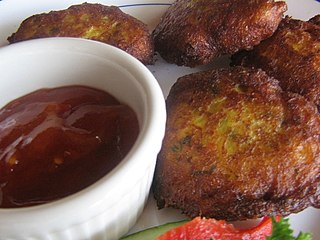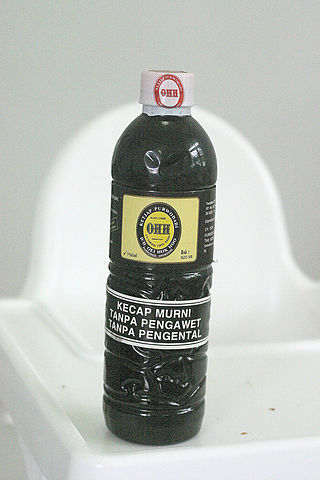
The Kraft Heinz Foods Company, formerly the H. J. Heinz Company and commonly known as Heinz, is an American food processing company headquartered at One PPG Place in Pittsburgh, Pennsylvania. The company was founded by Henry J. Heinz in 1869. Heinz manufactures food products in plants on six continents, and markets these products in more than 200 countries and territories. The company claims to have 150 number-one or number-two brands worldwide. Heinz ranked first in ketchup in the US with a market share in excess of 50%; the Ore-Ida label held 46% of the frozen potato sector in 2003.

Ketchup or catsup is a table condiment with a sweet and sour flavor. "Ketchup" now typically refers to tomato ketchup, although early recipes for various different varieties of ketchup contained mushrooms, oysters, mussels, egg whites, grapes, or walnuts, among other ingredients.

Tahu goreng or Tauhu goreng is a generic name for any type of fried tofu dish in the cuisines of Indonesia, Brunei, Malaysia and Singapore.

Chinese Indonesian cuisine is characterized by the mixture of Chinese with local Indonesian style. Chinese Indonesians, mostly descendant of Han ethnic Hokkien and Hakka speakers, brought their legacy of Chinese cuisine, and modified some of the dishes with the addition of Indonesian ingredients, such as kecap manis, palm sugar, peanut sauce, chili, santan and local spices to form a hybrid Chinese-Indonesian cuisine. Some of the dishes and cakes share the same style as in Malaysia and Singapore, known as Nyonya cuisine by the Peranakan.

Nasi goreng, is a Southeast Asian rice dish with pieces of meat and vegetables added. It can refer simply to fried pre-cooked rice, a meal including stir-fried rice in a small amount of cooking oil or margarine, typically spiced with kecap manis, shallot, garlic, ground shrimp paste, tamarind and chilli and accompanied by other ingredients, particularly egg, chicken and prawns. There is also another kind of nasi goreng which is made with ikan asin which is also popular across Indonesia.

Chili sauce and chili paste are condiments prepared with chili peppers.

Javanese cuisine is the cuisine of Javanese people, a major ethnic group in Indonesia, more precisely the province of Central Java, Yogyakarta and East Java.

Kwetiau goreng is an Indonesian style of stir-fried flat rice noodle dish. It is made from noodles, locally known as kwetiau, which are stir-fried in cooking oil with garlic, onion or shallots, beef, chicken, fried prawn, crab or sliced bakso (meatballs), chili, Chinese cabbage, cabbages, tomatoes, egg, and other vegetables with an ample amount of kecap manis. In Asia, kwetiau is available in two forms, dried and fresh. Its recipe is quite similar to another Chinese Indonesian favourite, mie goreng, except for the use of flat rice noodles in kwetiau goreng.

Bubur ayam is an chicken congee dish served in Southeast Asia. It is rice congee with shredded chicken meat served with some condiments, such as chopped scallion, crispy fried shallot, celery, tongcay or chai poh, fried soybean, crullers, both salty and sweet soy sauce, and sometimes topped with yellow chicken broth and kerupuk. Unlike many other rice dishes, the dish is not spicy as the sambal or chili paste is often served separately. It is a favourite breakfast food, served by humble travelling vendors, warung, fast food establishments, and five-star hotel restaurants. Travelling bubur ayam vendors frequently pass through residential streets in the morning selling the dish.

Bumbu is the Indonesian word for a blend of spices and for pastes and it commonly appears in the names of spice mixtures, sauces and seasoning pastes. The official Indonesian language dictionary describes bumbu as "various types of herbs and plants that have a pleasant aroma and flavour — such as ginger, turmeric, galangal, nutmeg and pepper — used to enhance the flavour of the food."

Colo-colo is an acidic condiment commonly found in Maluku archipelago, Indonesia. It is believed to have originated in Ambon city, and accordingly is often described as Ambon's sambal. Colo-colo is similar to Manado's dabu-dabu, as they both use many chopped red chili peppers, bird's eye chili, shallots, red and green tomatoes, and a pinch of salt and sugar, mixed with fresh calamansi juice or locally known as lemon cui or jeruk kesturi. The main difference is that colo-colo recipe often includes additional ingredients, such as chopped lemon basil, kenari nut, and tahi minyak or ampas minyak, or caramelized rarobang. As a result, colo-colo is darker and more oily than dabu-dabu.

Lumpia(in Indonesian and Filipino) are various types of spring rolls commonly found in Chinese Indonesian and the Chinese Filipino cuisines. Lumpia are made of thin paper-like or crepe-like pastry skin called "lumpia wrapper" enveloping savory or sweet fillings. It is often served as an appetizer or snack, and might be served deep-fried or fresh (unfried). Lumpia are Indonesian and Filipino adaptations of the Fujianese rùnbǐng and Teochew popiah, usually consumed during Qingming Festival.

Ayam bakar is an Indonesian and Malay dish, consisting of charcoal-grilled chicken. Ayam bakar literally means "grilled chicken" in Indonesian and Malay.

Ikan goreng is a hot dish consisting of deep fried fish or other forms of seafood. Ikan goreng literally means "fried fish" in Indonesian and Malay languages.

Sambal is an Indonesian chili sauce or paste, typically made from a mixture of a variety of chilli peppers with secondary ingredients such as shrimp paste, garlic, ginger, shallot, scallion, palm sugar, and lime juice. Sambal is an Indonesian loanword of Javanese origin. It originated from the culinary traditions of Indonesia and is also an integral part of the cuisines of Singapore, Malaysia, Brunei, and Sri Lanka. It has also spread through overseas Indonesian populations to the Netherlands and Suriname.

Ikan bakar is an Indonesian and Malay dish, prepared with charcoal-grilled fish or other forms of seafood. Ikan bakar literally means "grilled fish" in Indonesian and Malay. Ikan bakar differs from other grilled fish dishes in that it often contains flavorings like bumbu, kecap manis, sambal, and is covered in a banana leaf and cooked on a charcoal fire.

Sweet soy sauce is a sweetened aromatic soy sauce, originating in Indonesia, which has a darker color, a viscous syrupy consistency, and a molasses-like flavor due to the generous addition of palm sugar or jaggery. Kecap manis is widely used with satay. It is similar to, though finer in flavor than, Chinese Tianmian sauce (tianmianjiang). It is by far the most popular type of soy sauce employed in Indonesian cuisine and accounts for an estimated 90 percent of the nation's total soy sauce production.



















